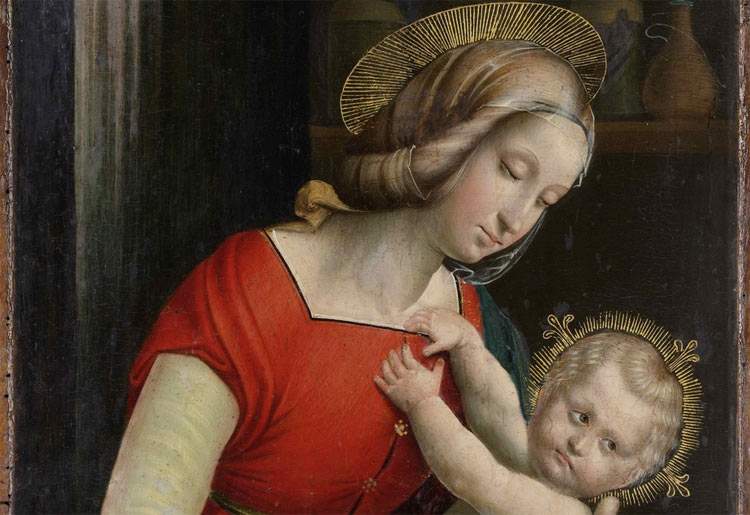Turin, at the Galleria Sabauda an exhibition goes on the trail of Raphael in Piedmont
From October 30, 2020 to March 14, 2021, the Galleria Sabauda in Turin is hosting the exhibition On the Traces of Raphael in the Savoy Collections, an exhibition that the Royal Museums of Turin is organizing on the 500th anniversary of the death of Raphael Sanzio (Urbino, 1483 - Rome, 1520): the exhibition, through paintings, engravings and decorative art objects, illustrates the spread of models derived from his work from the first half of the 16th century to the end of the 19th century, in Piedmont and in the collections of the Savoy family.
There are 33 works on display: the art of Raphael is evoked through works derived directly from his models, either through the practice of copying or through the free reinterpretation of his inventions. The Urbino’s style, characterized by gentleness and elegance, extraordinary drawing skills, precious colors and perfect compositional balance, became a reference for every artistic genre since the 16th century. The first part of the exhibition itinerary is devoted to antique copies of the famous Madonna d’Orle?ans, an early work by Raphael that may have belonged to Duke Charles II of Savoy, now preserved at the Conde? Museum in Chantilly and replicated as early as the first half of the 16th century by some of the leading artists active in the Piedmont area. Also derived from a Raphaelesque model is the Madonna of the Curtain in the Savoy collections, restored with the collaboration of the La Venaria Reale Conservation and Restoration Center and the support of Intesa Sanpaolo. Believed in the early 19th century to be an autograph work by the master and sold as such in 1828 to the Prince of Carignano Carlo Alberto, it was later attributed to collaborators such as Perin del Vaga and Giovan Francesco Penni. Investigations conducted on the occasion of the exhibition, on the other hand, lean toward a realization around 1530-1540 in Florence, in a prestigious workshop such as that of Andrea del Sarto.
The second part presents a selection of prints of sacred, mythological and allegorical subjects, where Raphael’s models are revisited in an original way. The circulation of models through repertories and collections of prints is also documented in the minor arts, as attested by the Flemish tapestry with The Entrance of the Animals into Noah’s Ark, which cites the Vatican Stanze, and the enamels on porcelain by the Genevan painter Abraham Constantin, a witness to the nineteenth-century phase of the cult of Raphael. The itinerary is completed on the second floor of the Galleria Sabauda, where works by 16th-century artists who measured themselves against Raphael and the ideal of an art of unsurpassed perfection are on display.
The exhibition was organized in partnership with Intesa Sanpaolo and in collaboration with La Venaria Reale Conservation and Restoration Center.
“Raphael has represented, over the centuries, the supreme interpreter of beauty and grace. A genius capable of combining formal harmony with the throb of life,” says Enrica Pagella, Director of the Royal Museums of Turin. “In this exhibition dossier we have collected some episodes of the seduction he exercised on the princes of Savoy, with still little-known works that have been studied and restored for this occasion. It is an itinerary full of curiosities and surprises, and I am grateful to Intesa Sanpaolo for supporting it and to the restorers of the Venaria Reale Center for helping us with the research. A collaboration that is, together with the exhibition, a sign of life that continues and perhaps helps us to look beyond the uncertainties and fears of the present time.”
“We welcomed with great enthusiasm the entrustment of this extraordinary case study by the Royal Museums,” stresses Stefano Trucco, President of the Centro Conservazione Restauro La Venaria Reale, “and we thank Intesa Sanpaolo for helping to support the operations. In the course of the work, our interdisciplinary working group was able to discuss technical and scientific issues with leading research institutes and laboratories, expanding collaborations and the usual network of partnerships. We are particularly happy, concludes Trucco, to have contributed to the process of knowledge triggered by the Royal Museums, which is presented today in this Exhibition, and we are convinced that restoration is increasingly a moment of growth and professional exchange for all the entities involved.”
“It has never been more important than at this time,” says Michele Coppola, Executive Director Art, Culture and Historical Heritage Intesa Sanpaolo, “to support the world of culture and Intesa Sanpaolo once again confirms its solid presence alongside public institutions, Turin and the country. Our Bank’s Progetto Cultura continues and strengthens its commitment to defend and promote the value of Italy’s art heritage, which finds precisely in Raphael’s painting one of its finest and highest expressions.”
| <img src='https://cdn.finestresullarte.info/rivista/immagini/2020/fn/defendente-ferrari-madonna-con-bambino-da-raffaello.jpg' ' alt="Defendente Ferrari, Madonna and Child, by Raphael (1526; oil on panel; Amsterdam, Rijksmuseum) " title="Defendente Ferrari, Madonna and Child, by Raphael (1526; oil on panel; Amsterdam, Rijksmuseum) " /></td></tr><tr><td>Defendente Ferrari, <em>Madonna and Child</em>, by Raphael (1526; oil on panel; Amsterdam, Rijksmuseum) </td></tr></table></p> |
 |
| Turin, at the Galleria Sabauda an exhibition goes on the trail of Raphael in Piedmont |
Warning: the translation into English of the original Italian article was created using automatic tools. We undertake to review all articles, but we do not guarantee the total absence of inaccuracies in the translation due to the program. You can find the original by clicking on the ITA button. If you find any mistake,please contact us.




























